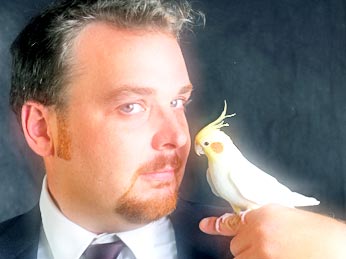
Parrots have been kept as pets for several centuries. Ancient texts, including the Afghanistan document called The Masnavi dating back to 1250 CE, speaks of the process of teaching them to talk:
Parrots are taught to speak without understanding the words. The method is to place a mirror between the parrot and the trainer. The trainer, hidden by the mirror, utters the words, and the parrot, seeing his own reflection in the mirror, fancies another parrot is speaking, and imitates all that is said by the trainer behind the mirror.
Well, today’s modern trainers don’t necessarily use mirrors. However, people do agree that it’s best to think that humans are just “Featherless parrots”—by interacting with them as frequently as they would have with any other member of the flock. It’s important to get the parrots when they’re young, hand feed them, and spend several hours a day just building your bond. Once they realize that you are kind, patient, and trustworthy, they will be eager to please you and become very enthusiastic about your training sessions together.
Of course, this process takes time. When they first enter your home, your parrot may actually withdraw—overwhelmed by the new surroundings, unsure of what to expect. Give it time to settle down and familiarize itself with the new set up. Talk to it as often as possible, in a low and gentle voice.
The next step is to let the parrot get used to perching on your hand. It may panic when it sees you place your finger inside the cage; in that case, just stop and keep still, without actually removing your hand. Wait until the bird relaxes before coming any closer.
Here is an important tip: remove your hand only when it settles down. If you remove your hand when it reacts violently, it will continue to throw “fits” if only to make you go away. Then let the parrot associate your hand with “good” things like treats, toys, and later on, being petted.
Parrots Training-Teaching parrots how to talk
There are many species of parrots, with each having its own set of natural talents. For example, cockatoos and ringneck parrots are prolific talkers, while others are better at acrobatic tricks.
Parrots can learn words just by hearing them regularly (so be careful about what you say around it!). However, you can have “formal language classes” of about 10 to 15 minutes every day. It’s best to conduct these in a quiet room that’s free of any distractions.
Start with simple phrases like “Good morning!” Repeat several times, and if it as much as squeaks in response, give it a treat before repeating the word again. Lavish a lot of praise.
Introduce one phrase or word at a time to avoid confusing the parrot. It may take weeks for it to get the hang of it, but even if you never get past “hello” these training sessions are a wonderful way of bonding with your pet.